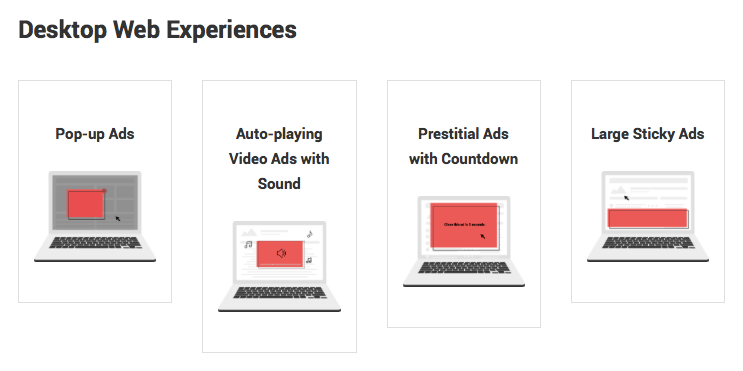Chrome will block all ads on “bad” sites, and “Yandex Browser” will cut out individual banners

Desktop advertising formats for which Chrome will “fine” websites
On December 19, 2017, Google recalled its support for the Better Ads Standards quality advertising standards , which the Coalition for Best Advertising approved the day before.
Website owners have a month and a half to check ads on their websites for violations. Starting February 15, 2018, in accordance with the recommendations of the Coalition, the Chrome browser will begin to block all ads on sites that have not received normal status in the Ad Experience Report for the last 30 days (that is, they have “failing” status). The site can apply for a status change when it removes all the shortcomings of advertising formats. For more information on the status of sites, see the help center and forums .
Yandex.Browser will work in the same way, although it has not joined any coalitions. Here, the developers decided on the standards of poor-quality advertising as a result of a meeting with the association IAB Russia, Kommersant writes.
Interestingly, the start date of ad blocking in Chrome is not tied to the release of a new version of the browser. According to the schedule, Chrome 64 will be released on January 23, and Chrome 65 is scheduled for March 6. Apparently, Google activates the blocking function remotely.
Following the example of Chrome, Yandex. Browser will also start blocking poor-quality ads in its browser. And here, Russian developers have tried even to outrun Google a little: blocking poor-quality advertising will start from the first week of February, and not from February 15, like that of its main competitor.
By substandard advertising, “Yandex” refers the following:
- static ad unit on the whole screen, which can be closed only after the countdown;
- large pop-up windows covering content;
- video ads with automatic sound activation;
- large banners at the top or bottom of the page, covering its content.
The volume of such advertising on the Internet does not exceed 5%, but it prevents everyone, including the owners of other sites. Indeed, because of this intrusive advertising, more and more users install blockers that hide all the ads in general: “Now, because of one site that has placed an advertisement that is very outraged, all sites suffer, as this prompts the user to install a blocker. Such a program will continue to block all or almost all advertising, including useful, on any site, ”explains Dmitry Timko, head of the Yandex.Browser product management department.
In Yandex, they explained that such a blockage is introduced so that fewer users install blockers, because these extensions to the browser now "are a threat" to Yandex’s revenues. On average, in Yandex Browser, the proportion of users who installed the blocker reaches 22%, and among active users - 26%. “The share of blocker users is growing, and it looks like a vicious circle. The sites are trying to deal with them, often using even more annoying formats or not giving the opportunity to view the content, ”said Karen Ghazaryan, head of the analytical department of the Russian Association of Electronic Communications.
Probably, Google’s motivation for blocking unwanted ads is about the same as Yandex’s. But only Google acts more radically, blocking all advertising on “bad” websites, that is, effectively depriving the site owners of their livelihood. Such is the fee for disrespecting users.
Yandex is doing more humanely and leaves pests with all advertisements except those that break the rules. As Dmitry Timko said, this is done in order “not to kill the business site at the same time”.
Representatives of IAB Russia express the hope that the initiative of Google and Yandex, as a kind of moderator of advertising quality, will benefit the market. The amount of poor-quality advertising will decrease, and the share of users with blockers should not grow so fast as to threaten the business. According to the Association of Communication Agencies of Russia, the volume of online advertising in January-September 2017 amounted to 115–116 billion rubles.
All Articles